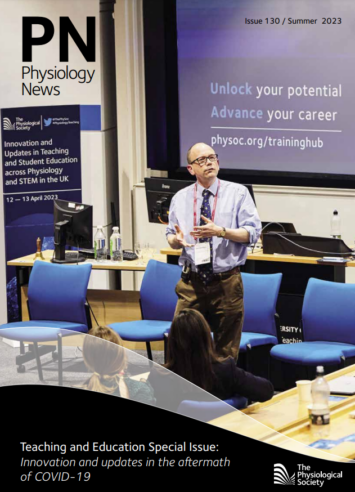
Physiology News Magazine
Meeting report: Europhysiology 2022 Teaching Symposium Report: Research-Based Learning Design and Active Learning Spaces in Physiology Teaching
18 September 2022, Copenhagen, Denmark
Events
Meeting report: Europhysiology 2022 Teaching Symposium Report: Research-Based Learning Design and Active Learning Spaces in Physiology Teaching
18 September 2022, Copenhagen, Denmark
Events
https://doi.org/10.36866/pn.130.38
Dr Clare Ray
University of Birmingham, UK
Dr Nicole Schmitt
University of Copenhagen, Denmark
Professor Chaya Gopalan
Southern Illinois University Edwardsville, US
Dr Charlotte Haigh
University of Leeds, UK
The Teaching Symposium at Europhysiology 2022, Research-Based Learning Design and Active Learning Spaces in Physiology Teaching, took place on Sunday 18 September 2022 and despite being scheduled the morning after the conference dinner was very well attended by an engaged and interactive audience. The aim of the symposium, co-chaired by Dr Nicole Schmitt of the University of Copenhagen, Denmark, and Dr Clare Ray of the University of Birmingham, UK, was to showcase the various elements of active learning that can be introduced into physiology teaching in a variety of achievable ways.

Adopting an active teaching approach
Clare introduced the symposium and discussed some of the evidence that supports the use of active teaching in physiology. She shared some of her own examples and experiences of using active approaches to learning and adapting assessments to evaluate understanding and deep learning. These included the use of the flipped classroom approach for the delivery of respiratory physiology to large groups of medical students (~400 students), online platforms including Lt (ADInstruments) to support engagement prior to and during laboratory practicals, and digital tools like Padlet to support discussion activities in small group sessions. She highlighted the importance of explaining to students the rationale for adopting an active approach, including sharing with them the evidence to support its use.
Flipped teaching
Chaya Gopalan (Southern Illinois University Edwardsville, US) started her presentation by defining flipped teaching. Next, she introduced her study design involving faculty from two different institutions attending faculty development workshops to be able to implement flipped instruction in their classrooms. Cohort 1 was testing flipped teaching implementation for a year before cohort 2 started, and therefore, cohort 1 mentored cohort 2. Chaya discussed how faculty perceptions, attitudes, and intentions toward flipped teaching implementation became more positive as they developed expertise. She also shared how participants continued to use flipped teaching in the remote setting during COVID-19 and reported that flipped teaching knowledge and resources helped them transition more quickly than those who did not. She talked about how students with greater college experience found flipped teaching more helpful than first-year students. She concluded by saying how flipped teaching could be used in multiple settings to engage students.
Active learning methodologies
Charlotte Haigh (University of Leeds, UK) discussed with us a module that encompasses research-based content, that is framed around what competencies students wish to gain experience in, and delivered using active learning methodologies, assessed in an inclusive manner. Researchers pitch their research projects to students who are Year 2 undergraduates from a variety of disciplinary backgrounds. The students then choose a research project and design a public engagement event to help communicate the research to a specific audience of their choice. Each session supports this outcome, by utilising guest speakers and interactive discussions that will help the students plan such an activity. The students have a choice of assessment outputs, such as writing a grant proposal, recording a short presentation or producing a digital portfolio to pitch the idea to a grant body for funding. This is all supported by formative feedback on initial ideas before the output for assessment.
A student-centred learning approach
Nicole shared some of the theoretical basis for her teaching practice in various study programmes (e.g. medicine, odontology, medicine & technology) at the University of Copenhagen. She introduced the student-centred learning approach by Knud Illeris, where the individual’s learning takes place in the interplay between cognitive, social and psychodynamic dimensions (Illeris, 2018). She presented the concept of the “implied student” (Ulriksen, 2009) and stressed the importance of safe learning environments and alignment of expectations to increase the students’ activity, reflection and learning. Her examples for activating teaching formats revolved around synchronous, hybrid, and interactive lectures with up to 400 students and aimed to demystify the use of activating formats in the lecture setting. The examples included direct feedback using student response systems with quizzes at different taxonomic levels and examples for successful group work in the lecture setting.
The final 30 minutes of the symposium allowed those attending to discuss the question How can we support one another to develop active learning and teaching in physiology? There was lively discussion in the room and on the dedicated Padlet discussion board, which continued into the final question and answer moderated podium discussion where many ideas were shared. There was a lot of enthusiasm for further collaboration between individuals and the various physiological societies represented. We hope to see the results that arise from these conversations presented at future meetings.
For those unable to attend Europhysiology 2022, recordings of the symposium talks are available on the websites of the Scandinavian Physiological Society and The Physiological Society’s Training Hub.
References
Illeris Knud (2018). Contemporary Theories of Learning: Learning Theorists … In Their Own Words. 2nd edition.Milton Park, Abingdon, Oxon; New York, NY: Routledge. Ulriksen L (2009). The Implied Student. Studies in Higher Education 34 (5): 517–32. https://doi.org/10.1080/03075070802597135
